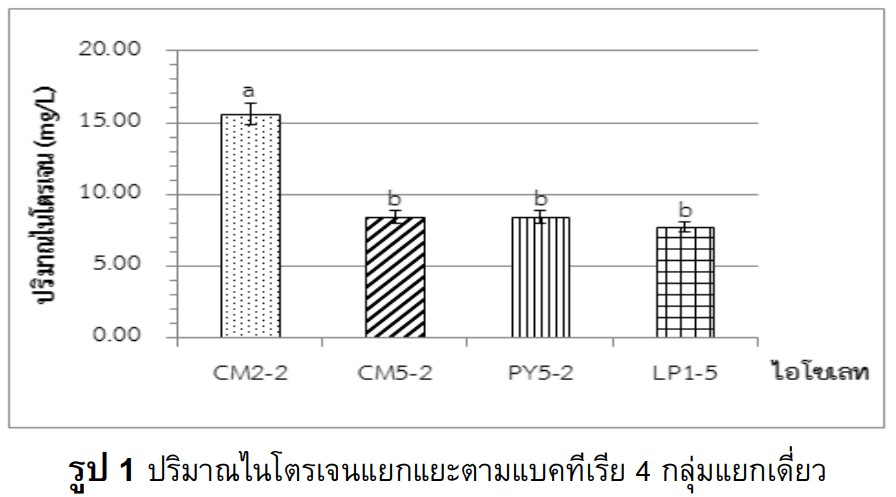การคัดเลือกแบคทีเรียตรึงไนโตรเจนอิสระเพื่อส่งเสริมการเจริญเติบโตของข้าว
คำสำคัญ:
แบคทีเรียตรึงไนโตรเจน, ดินรอบรากข้าว, ปุ๋ยชีวภาพ, การใส่เชื้อบทคัดย่อ
การศึกษามุ่งหมายเพาะเลี้ยงแบคทีเรียจากรอบรากข้าว และเลือกแบคทีเรียตรึงไนโตรเจน จากตัวอย่างดินรอบ รากข้าว มีแบคทีเรีย 310 กลุ่มแยกเดี่ยว พร้อมด้วยแบคทีเรียตรึงไนโตรเจน 26 กลุ่มแยกเดี่ยว การทดสอบคุณสมบัติแสดง ให้เห็นแบคทีเรีย 10 กลุ่มแยกเดี่ยว มีประสิทธิภาพตรึงไนโตรเจนสูง และผลิตอินโดลอะซีติก จําแนกแบคทีเรียคัดเลือกได้ อาศัยการวิเคราะห์ลําดับยีน 16S rRNA บ่งชี้ 3 สายพันธุ์ อย่างเช่น Bacillus altitudinis CM2-2, Bacillus aryabhattai LP1-5 และ Pseudomonas nitroreducens PY7-6 ผลิตสารประกอบไนโตรเจนสูง 15.60 ± 0.40, 7.70 ± 0.70 และ 6.30 ± 0.10 มก. ต่อลิตร ตามลําดับ นอกจากนี้แล้ว Pseudomonas nitroreducens PY7-6 ให้อินโดลอะซีติกสูงสุด 23.90 ± 0.20 มก. ต่อลิตร ใส่ปุ๋ ยเคมี NPK และแบคทีเรียเพาะเลี้ยงลงในกระถางข้าวต้นอ่อนอายุ 30 วัน การใส่ปุ๋ ย NPK และ Bacillus altitudinis CM2-2 เป็นกรรมวิธีดีที่สุดต่อต่อการเจริญของข้าว ประกอบด้วย ความสูงลําต้น ความยาวราก จํานวนใบ นํ้าหนักสดและ นํ้าหนักแห้ง แตกต่างจากอย่างมีนัยสําคัญเปรียบเทียบกับกลุ่มควบคุม อย่างไรก็ตาม ไม่มีความแตกต่างเกี่ยวกับปริมาณ ไนโตรเจน สรุป Bacillus altitudinis CM2-2 อาจพัฒนาเป็นปุ๋ยชีวภาพ
เอกสารอ้างอิง
2. Osotsapar Y. Plant Nutrient. Bangkok: Kasetsart University Press; 2009.
3. Magrin G, García CG, Choque DC, Giménez JC, Moreno AR, Nagy GJ, et al. Latin America. Climate change 2007: Impacts, adaptation and vulnerability. Contribution of working Group II to the fourth assessment report of the intergovernmental panel on climate change. In: Parry ML, Canziani OF, Palutikof JP, van der Linden PJ, Hanson CE, editors. Cambridge: Cambridge University Press; 2007. p. 581-615.
4. Feng Y, Shen D, Song W. Rice endophyte Pantoea agglomerans YS19 promotes host plant growth and affects allocations of host photosynthates. J Appl microbial. 2006;100(5):938-945
5. Glick BR, Bashan Y. Genetic manipulation of plant growth-promoting bacteria to enhance biocontrol of phytopathogens. Biotechnol Adv. 1997;15(2):353-378.
6. Laskar F, Sharma GD. Isolation and characterisation of Diazotrophic bacteria from rhizosphere of different rice cultivars of south Assam, India. Curr World Environ. 2013;8(1):157-163.
7. Slavov S, Van Onckelen H, Batchvarova R, Atanassov A, Prinsen E. IAA production during germination of Orobanche spp. Seeds. J Plant Physiol. 2004;161(7):847-853.
8. San-Francisco S, Houdusse F, Zamarreño AM, Garnica M, Casanova E, García-Mina JM. Effects of IAA and IAA precursors on the development, mineral nutrition, IAA content and free polyamine content of pepper plants cultivated in hydroponic conditions. Sci Hortic. 2005;106(1):38-52.
9. Khan MM, Khatun A, Islam MT. Promotion of plant growth by phytohormone producing bacteria. In: Garg N, Aeron A, editors. Microbes in Action. USA: Nova Science Publishers; 2016. p. 45-76.
10. Davies PJ. Plant hormones and their role in plant growth and development. The Netherland: Dordrecht; 1990.
11. Bal HB, Nayak L, Das S, Adhya TK. Isolation of ACC deaminase producing PGPR from rice rhizosphere and evaluating their plant growth promoting activity under salt stress. Plant Soil. 2013;366(1-2):93-105.
12. Lavakush Yadav J, Verma JP, Jaiswal KD, Kumar A. Evaluation of PGPR and different concentration of phosphorus level on plant growth, yield and nutrient uptake of rice (Oryzasativa). Ecol Eng. 2014;62:123-128.
13. Thazin NA, Nourmohammadi S, Sunitha EM, Myint M. Isolation of endophyticbacteria from green gram and study on their plant growth promoting activities. Inter J Appl Biol Phar Technol. 2011;2(3):525-537.
14. Bashir A, Midrarullah, Mirza MS. Effects of inoculation with plant growth promotingrhizobacteria (PGPRs) on different growth parametersof cold area rice variety, Fakremalakand. Afr J Microbiol Res. 2013;7(17):1651-1656.
15. Babalola OO. Beneficial bacteria of agricultural importance. Biotechnol Lett. 2010;32(11):1559-1570.
16. Dobereiner J, Marriel IE, Nery M. Ecological distribution of Spirillum lipoferum Beijerinck. Can Microbiol. 1976;22(10):1464-1473.
17. Ahmad F, Ahmad I, Khan MS. Screening of free-living rhizospheric bacteria for their multiple plant growth promotion activities. Microbiol Research. 2008;163(2):173-181.
18. Bharucha U, Patel K, Trivedi UB. Optimization of indole acetic acid production by Pseudomonas putida UB1 and its effect as plant growth-promoting rhizobacteria on mustard (Brassica nigra). Agri Res. 2013;2(23): 215-221.
19. Ahmad M, Nangyal H, Imran M, Ullah F. Optimization of protocol for surface sterilization and callus induction for three rice varieties. Am-Eurasian J Agri Environ Sci. 2016;16(2):357-361.
20. Division of Rice Research and Development Rice department. Planting, maintenance and fertilizer use in rice fields. [Internet]. 2012 [cited 2014 Nov 21]. Available from: http://www.ricethailand.go.th/Rkb/management/ index.php.htm

ดาวน์โหลด
เผยแพร่แล้ว
รูปแบบการอ้างอิง
ฉบับ
ประเภทบทความ
สัญญาอนุญาต
ผู้นิพนธ์ต้องรับผิดชอบข้อความในบทนิพนธ์ของตน มหาวิทยาลัยพะเยา ไม่จำเป็นต้องเห็นด้วยกับบทความที่ตีพิมพ์เสมอไป ผู้สนใจสามารถคัดลอก และนำไปใช้ได้ แต่จะต้องขออนุมัติเจ้าของ และได้รับการอนุมัติเป็นลายลักษณ์อักษรก่อน พร้อมกับมีการอ้างอิงและกล่าวคำขอบคุณให้ถูกต้องด้วย







